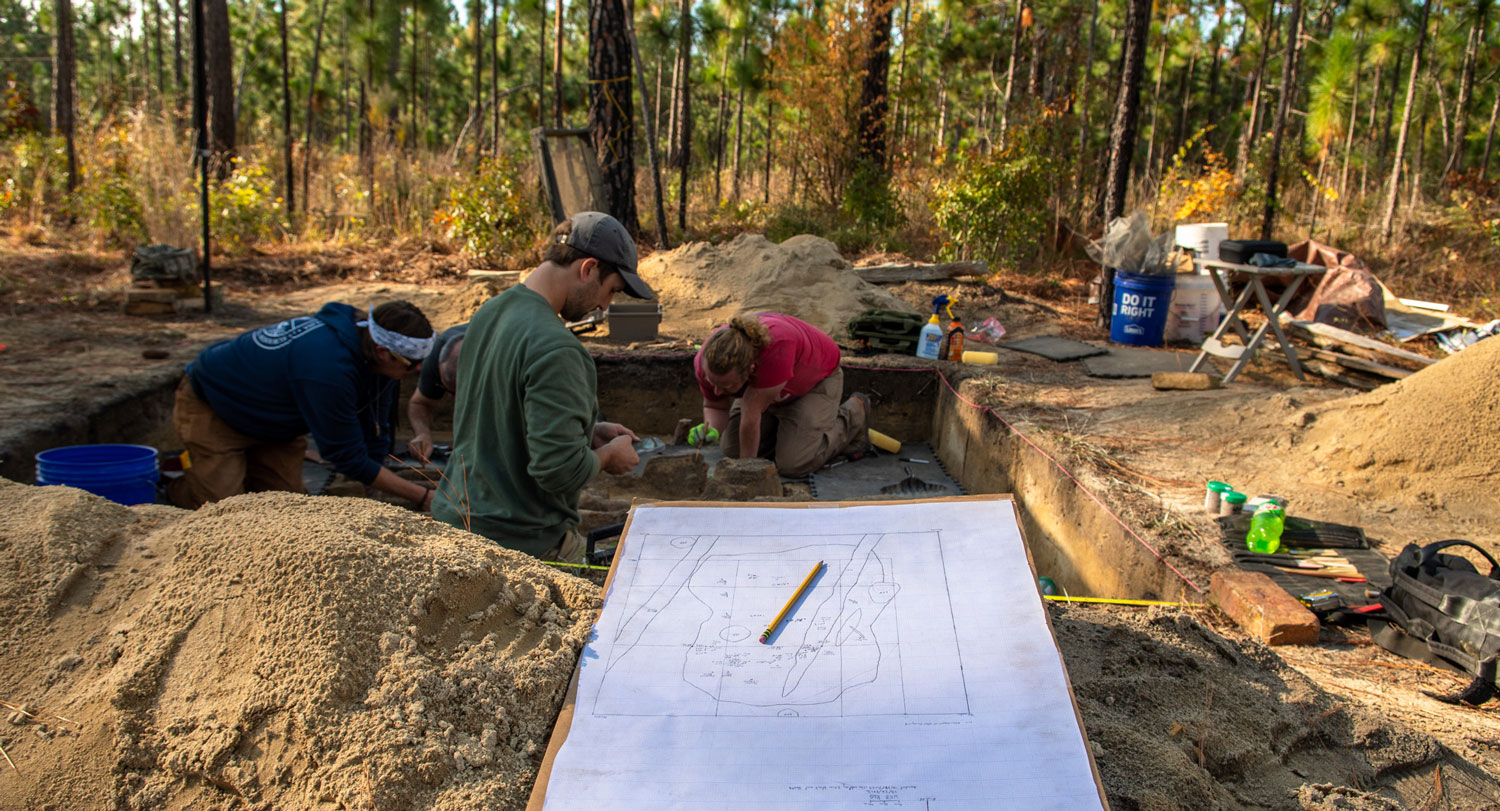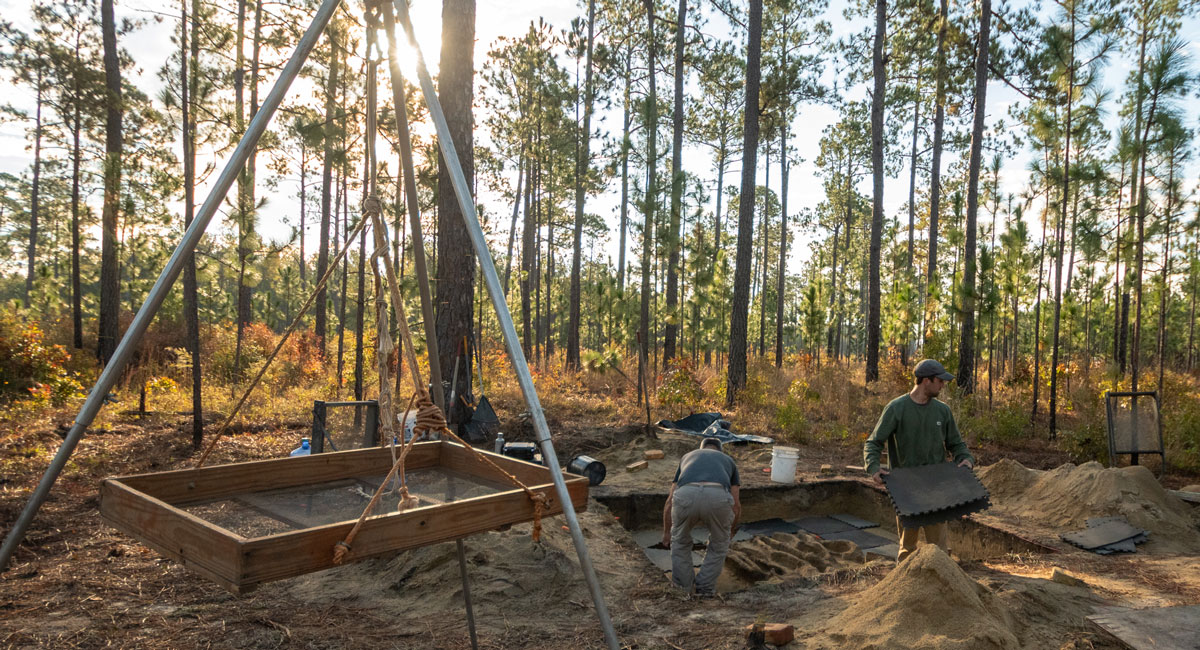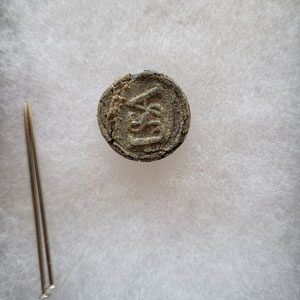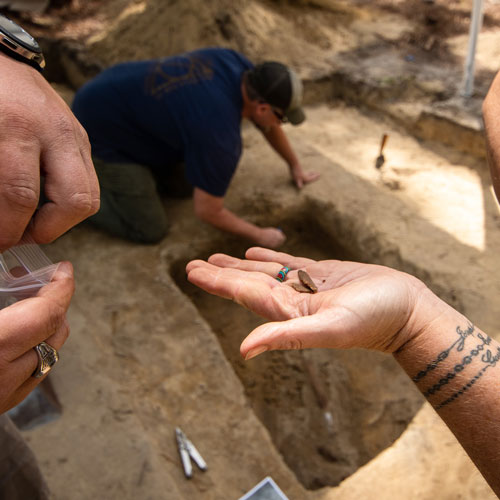
Archaeologists with the South Carolina Institute of Archaeology and Anthropology at USC have studied the Camden Battlefield for decades, but their most recent finding is the discovery of a lifetime.
The SCIAA team found the remains of 14 Revolutionary War soldiers at the historic Camden Battlefield and Longleaf Pine Preserve, the site of a 1780 battle that claimed more lives than any other in the revolution.
“I was standing over the grave of a soldier who woke up that morning not knowing it was his last,” says Doug Bostick, executive director of the South Carolina Battleground Preservation Trust. “It’s a surreal experience that connected me with military history (in a way) that I’ve never felt before.”
The trust preserves historic battle sites across the state, including the Camden site. Together with SCIAA and a handful of other invested organizations, researchers are piecing together what this discovery means for South Carolina's history and what we know about the deadliest battle of the American Revolution.
Steven D. Smith, research professor and lead on the Camden site, says the project aims to learn more about the lives of Revolutionary War soldiers, excavate remains that were endangered from human discovery and rebury them with dignity.

Revealing battlefield burials
Many people do not realize that historic battle sites are often cemeteries because fallen soldiers were buried where they fell during the Revolutionary War and are still there, says SCIAA archaeologist James Legg, who has studied the Camden battle site since 1980.
Beginning in 2020, SCIAA archaeologists discovered the bodily remains and personal artifacts of several soldiers who fought at the Battle of Camden buried in shallow graves. This year, the Battleground Trust and SCIAA finalized plans to excavate the site.
Working from September to early November, the archaeologists unearthed 14 individuals in seven graves, including one which held five bodies. The shallow gravesites provide insight into burial practices during the war.

“The burials were very cursory in nature,” Legg says. “Prisoners of war were likely
made to bury the dead in extremely shallow graves — we’re talking 12 to 14 inches
deep. Some of them even showed evidence of plow marks from 20th century farm machinery,
that’s how poorly these soldiers were treated.”
The manner and location of the graves informs the history of the battle itself, including
the participants and the skirmish areas. Artifacts found with the skeletal remains,
such as uniform buttons, reveal the soldiers’ allegiances: 12 Continental, one British
and one Loyalist.
Outside of the findings’ historical significance, Legg says this new evidence of battle helps solidify the reality of the war, which can be difficult to conceptualize outside of history books.
“It’s almost like a mythology, the Revolution, like a story we all agree happened, but may not feel that it was real. These gravesites make it real.”
Honoring America’s ‘first veterans’
Once the graves were identified and assessed, a SCIAA team carefully removed the soldiers’ remains to a lab for further study.
Carlina de la Cova, bioarcheologist and professor of anthropology, said many of the remains were extracted in blocks of soil to limit further damage. De la Cova, along with forensic examiners from the Richland County Coroner’s office, will X-ray the skeletons to learn about out each soldier’s age, height, cause of death and experience of battlefield trauma.
Several of her former students, now working at the coroner’s office, have volunteered to help with the project. Using dental evidence, they’ve already identified the ages of many of the soldiers. At least one half of them were under 35 years old, including two teens estimated to be ages 14-16. The Continentals came from Maryland or Delaware, and the British soldier was from Scotland.

“When we think about the independence of this nation, we think about the Declaration of Independence, we think about Washington crossing the Delaware, but here in South Carolina we have this very tangible evidence that tells the human side of that story,” de la Cova says.
While de la Cova values what she and the other researchers can learn from the fallen soldiers, she says her other focus is identifying the soldiers based on their biological profiles so they can be honored with a proper burial.
After the forensic data is collected, the soldiers will be reinterred in sealed vaults at the locations where they were found on the Camden Battlefield, Bostick says. S.C. Battleground Trust, Historic Camden and Kershaw Country are planning a service for April 2023.
“These are America’s first veterans,” Bostick says. “We think it’s important for the public to be able to see and understand all the things that will happen.”
Until then, the USC researchers will continue to learn what they can from the boys and men who gave the ultimate sacrifice.
“I felt honored to be there, to connect with the men who gave their lives for the liberty that we all enjoy today,” Bostick says. “They gave their lives for what they believed in.”
Learn more
To learn more about the recent discovery at Camden, visit the S.C. Battleground Trust website.